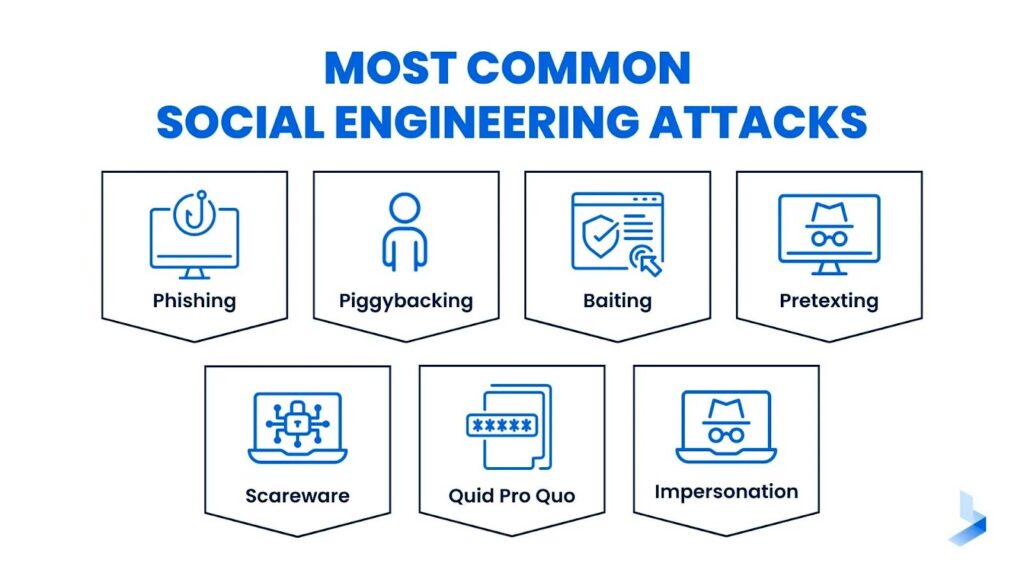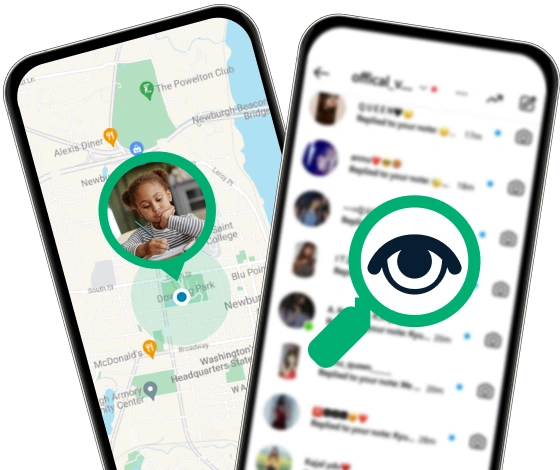Social engineering in its conventional context appeared many years ago: attackers quickly realized that to obtain the necessary information, it is enough to deceive a person, impersonate someone else, or take advantage of the interlocutor’s fears or complexes.
In the last century, ill-wishers used to manipulate victims via phone pranks, and with the advent of computers, social engineering has completely moved online.
The number of social engineering attacks by hackers is growing every year. To protect yourself from psychological and sociological attacks, you need to understand how the schemes of attackers work. We will discuss the main types of social engineering and methods of protection against them.
What Is Social Engineering?
Social engineering is a type of fraud that uses psychological methods and manipulation. In other words, social engineering is not about hacking a program or device but about “hacking” a person. As a result of social engineering, an attacker can gain access to confidential information or a secure device.
In addition, social engineering can be used to spoof, steal, or destroy information. Social engineering is based on psychological methods used to influence people’s behavior and obtain information from them.

Types of Social Engineering Attacks
During a social engineering attack, criminals use special tactics to obtain information about an organization or its information systems. Statistics confirm that criminals are actively targeting human networks using social engineering techniques. Let’s take a closer look at what they can be.
Phishing Attacks
One of the main social engineering methods – phishing – is to create a massive online mailing allegedly on behalf of a well-known organization. One of the well-known social engineering examples is the Office 365 phishing attack. In a classic phishing scheme, a user receives an email with a “reasonable” request to follow a sneaky link to authorize. The victim of the fraud does not realize that they are visiting a phishing site and provides the requested information. The types of phishing social engineering include the following:
- Voice phishing (vishing): a phone call from a scammer attempting to trick people into divulging personal information. Criminals often pose as legal organizations, using social marketing to sound authentic. Generally, victims are required to disclose personal data or credit card details under fabricated pretenses.
- SMS phishing: uses text messages to fool recipients into providing personal information. They often refer to malicious websites or explicitly request sensitive data. Messages may come from trusted sources, such as banks, and use urgency or fear to induce action.
- Email phishing: a widespread form of phishing that entails sending misleading emails meant to scam victims into revealing sensitive data. Fraud emails often emulate lawful companies by using authentic business logos and language. Normally, they contain links to malicious websites or specifically ask for personal information.
- Angler phishing: targets social media surfers. Attackers create false customer service profiles to interact with people, claiming to help them solve issues with their accounts. When they do so, they trick victims out of credentials or personal details by exploiting the confidence that social media interactions bring.
- Search phishing: this type of social hacking refers to the building of fraudulent websites that emerge in search engine results. These websites often provide seemingly too-good-to-be-true offers or experiences. Upon agreeing, victims are asked to enter private information or financial data, which scammers then use to steal their money.
- URL phishing: it uses malicious web addresses to redirect people to fake websites. Fake URLs often resemble real URLs, with small errors in spelling or various domains. Subsequently, unaware users who visit these sites may inadvertently enter their details into these bogus web pages.
- Whaling: a targeted form of phishing that attempts to target high-ranking individuals, and we have the whaling attack example against the CEO of the company FACC. Sophisticated social engineering attacks happen frequently, being well-developed and personalized, rendering them difficult to detect. Their purpose is to infiltrate sensitive data or disrupt high-level corporate cyber security.
- In-session phishing: occurs when a victim is actively connected to a valid service. Thieves utilize vulnerabilities to insert phishing pop-up messages or ransomware during the session. The pop-up messages usually demand re-authentication or credential confirmation, causing credentials or personal data to be exposed.
Pretexting
Another method of social engineering. A pretexting attack is an action worked out according to a pre-designed algorithm. A social hacker impersonates a person known to the potential victim to obtain the necessary data.
Attackers call citizens and introduce themselves as employees of financial institutions, call centers, or technical support. To inspire trust, fraudsters tell the caller information about them (e.g., name, position, date of birth) or the projects they are working on. Sometimes, the hacker introduces themselves as an acquaintance or family member and asks to transfer funds to a specified account quickly. The pretexting attack example was the Ubiquiti Networks Incident (2015), resulting in a loss of $46.7 million.

Access Tailgating Attacks
Third parties gain direct physical access to a restricted area during a tailgating attack by following an authorized person. Cases often occur in corporate or secure spaces where attackers abuse the politeness or inattention of legitimate employees to bypass security measures.
They may pretend to be a delivery person or have misplaced their access card, relying on someone to open the door. Inside, they can access sensitive information, install tracking devices, or commit various other forms of enterprise espionage.
Quid Pro Quo Attacks
Such attacks occur when a criminal offers a benefit or favor in return for data or access. The name of this method comes from the Latin phrase “quid pro quo”. The algorithm of the criminal’s actions is as follows: the ill-wisher calls the user, introduces themselves as a technical support employee, and reports software malfunctions. The unsuspecting person tries to help and follows the attacker’s instructions, providing access to critical information.
Baiting
A baiting attack involves infiltrating a malicious program into a victim’s computer. The idea is as follows: an email is sent with an offer to receive additional income, winnings, dirt on a colleague, an antivirus update, or other “bait”.
By downloading the program, the user infects their device with a virus that can collect or modify existing information. The file is carefully masked, so not everyone can recognize a fake. Attackers also leave malware-infected physical devices, such as USB drives or CDs, in places where potential victims can find them.
Scareware Attacks
Ransomware consists of fooling the victim into feeling that their computer is infected with malware or has significant technical problems. Users are deluged with fake news and messages urging them to take urgent action. Typically, this involves downloading malicious software or making payments for unnecessary technical support options. The well-known ransomware attack example was against U.K. rail operator Merseyrai.
Watering Hole Attacks
Cybercriminals target specific communities by infecting websites that they frequent. Initially, the intruders find and deface a website that members of the intended group access. After that, they inject malware into the website. As the targeted visitors attempt to access the compromised website, the malware is stealthily installed on their devices. It is especially dangerous because it exploits users’ trust in regular, often well-known, legitimate websites.
DNS Spoofing and Cache Poisoning Attacks
Also known as DNS cache poisoning, DNS spoofing refers to defacing the DNS lookup and resolution process. Cybercriminals install fake addresses in the DNS cache, so once people enter a legitimate website link, they are rerouted to a fraudulent site.
It enables malicious actors to steal information, spread malware, or disrupt services. It is dangerous because of the attack’s invisibility; users believe they are accessing legitimate sites while their data is being tampered with. The well-known DNS attack example was with Amazon Web Services System in 2018. One of their servers was acting as a fake DNS service, misleading users of the cryptocurrency website MyEtherWallet.com and redirecting them to a phishing site.

Unusual Social Engineering Methods
Recently, cybercriminals have begun to use more unusual and sophisticated social engineering techniques, going beyond more well-known tactics such as phishing or fake messages.
Social engineering statistics tell about an innovative method of using artificial intelligence (AI) to imitate voice. Intruders use deep learning patterns to clone a person’s voice, producing incredibly authentic audio. Frequently referred to as deep voice phishing, this method can trick individuals into thinking they receive instructions from a senior executive and encourage them to transfer funds or disclose confidential information. An unusual attack example is the deepfake attack on the UK energy company. The CEO of a UK energy provider was duped into transferring $243,000 to a scammer’s bank account in 2019. The scammer used AI technology to mimic the voice of the CEO’s boss in a phone call.
In addition, criminal actors use gamification to trap people into involuntary compliance with their attempts. By injecting malicious links or programs into online games or quizzes, intruders can trick victims into risking their safety. While these games often look innocent, they aim to fool users into completing certain actions or revealing information.
How to Avoid Falling a Victim to Social Engineering Attacks?
You’re working quietly at your computer, and suddenly, you receive an email with a message from employees of a company you supposedly know. How do you know if social engineering methods target you, and how do you avoid giving the attackers a chance? Pay attention to the following nuances:
- Spelling and punctuation mistakes, overly formal text style, and lack of logic and structure in the email should alert you.
- A sender’s address with incorrect or missing characters, as well as a kind of “abracadabra” is a marker that can help you recognize a fraudster.
- The letter requires an immediate response, and a sense of urgency arises after reading it.
How can you protect yourself from social engineering:
- Pay attention to the email sender’s address and the website where you intend to leave your data: we recommend checking the SSL certificate, the domain name (it should not contain any letter substitutions or missing characters), phone numbers, and company details.
- To keep your child’s device safe, you can set up parental control. This can be done with the help of various programs and applications, including uMobix.
- Do not work with important data in the presence of strangers. Fraudsters can use this situation to find passwords or other important information.
- Curiosity is a feeling that sometimes prompts us to open a file, forgetting about social security. Be vigilant: don’t go to dubious resources or download unknown programs.
- Use different passwords to access personal and corporate email, social media, and banking applications.
- Antivirus promptly signals the presence of threats, broken files, spam phishing, and unwanted programs. This purchase will pay off and save your data and a lot of nerve cells.

FAQ
Cybercriminals widely use social engineering attacks because they exploit human mentality and are often easier than hacking software. Their attacks attempt to manipulate trust and emotions to get people to willingly reveal or access sensitive information, avoiding traditional security measures.
Another type of social engineering that focuses on specific groups of people is known as spear phishing. Compared to broad, unselective phishing attacks, spear group phishing is extremely targeted. Malicious actors obtain specific information about their victims, such as personal data, professional roles, and connections.
Tailgating, dumpster diving, and shoulder surfing constitute examples of physically-based social engineering threats. Such methods aim to directly or indirectly obtain or acquire sensitive material through physical rather than digital means, taking advantage of human behavior and physical vulnerabilities.
A combination of education and awareness is the most successful approach to detecting and preventing social engineering attacks. Getting people to recognize and address suspicious requests, verifying identities and sources of information, and supporting a strong security culture are critical to fighting these exploits.




